
Aquatic physical therapy is a form of physical therapy that takes place in a pool or other water environment. It is often used in conjunction with land-based therapies for the treatment, management, and recovery of various conditions. Water’s buoyant, soothing properties offer less resistance making it ideal for patients with pain and difficulty performing certain exercises.
Continue reading to learn more about the benefits of aquatic therapy for patients of all ages and abilities.
Aquatic therapy is more than swimming laps in the pool. It is a safe and effective form of physical therapy utilizing evidence-based techniques to help patients move and feel better.
As with any physical therapy plan, aquatic therapy takes place under the supervision of a licensed physical therapist and follows a custom treatment plan based on the patient’s physical abilities and goals.
Aquatic physical therapy is recommended instead of or in conjunction with traditional physical therapy for patients whose symptoms and abilities necessitate a gentle, supportive exercise environment.
Lowers Fall Risk
Some patients who have issues with balance and stability may not be good candidates for land-based physical therapy. Yet water therapy reduces the risk of falls and fall injuries, allowing them to exercise and rehabilitate safely in a controlled environment.
Helps With Balance and Coordination
Aquatic therapy helps patients improve coordination and balance to reduce their risk of falls outside of the pool. Water slows down movement and stops falls, giving patients time to regain their posture if they get off balance. Research on the benefits of hydrotherapy shows that as older patients improve balance and recovery, they become less fearful of falling and more confident during activity.
Reduces Stress on Joints and Bones
Water reduces nearly 90% of body weight, when the patient is immersed to the neck. That buoyancy reduces the load on weight-bearing muscles, bones, and joints. This is ideal for anyone with a musculoskeletal condition or injury that would make landing on a hard surface unsafe or painful.
Builds Muscle Strength and Endurance
Because water is denser than air, it takes more effort to perform the same exercise in water than on land. This allows patients to increase muscle strength as they push against the water in a low-impact environment that will not stress vulnerable bones and tissues.
Increases Aerobic Capacity
Exercise increases aerobic capacity and breathing which is good for overall health. Aerobic exercise can reduce the risk of coronary artery disease and help to maintain a healthy blood pressure. This is good for patients who need aerobic activity but have pain and mobility issues that make land-based exercise challenging.
Improves Joint Flexibility
Water is conducive for greater range of motion in otherwise stiff joints. Warm water relaxes muscles which offloads tension from joints, allowing them to move more comfortably. Movement is medicine for individuals with arthritis and other joint conditions, making aquatic therapy a viable option for safe and gentle exercise.
Reduces Swelling
Hydrostatic pressure is pressure exerted by any type of fluid in a confined space. During aquatic physical therapy, water exerts hydrostatic pressure on the body. That pressure increases circulation and reduces swelling which in turn reduces joint stiffness and increases mobility.
Aquatic physical therapy is commonly used to treat the following conditions:
All the benefits listed above are more than just anecdotal. A wide body of research exists to back up these claims and confirm that aquatic therapy is a gentle and effective modality to treat and manage many common symptoms and health conditions.
One study published in early 2022 found patients with low back pain reported better outcomes from aquatic therapy than other physical therapy modalities for pain relief, improved sleep, and better quality of life.
Another study from 2020, determined that when water and land-based physical therapy were prescribed together, or in progression, patients had optimal results for training, conditioning, and rehabilitation. A systematic review of the research available on aquatic therapy for knee osteoarthritis confirmed this form of physical therapy had a positive effect on knee pain, function, strength, and walking.
Find a physical therapy clinic near you to schedule a screening and learn more about this fun and unique form of exercise.

